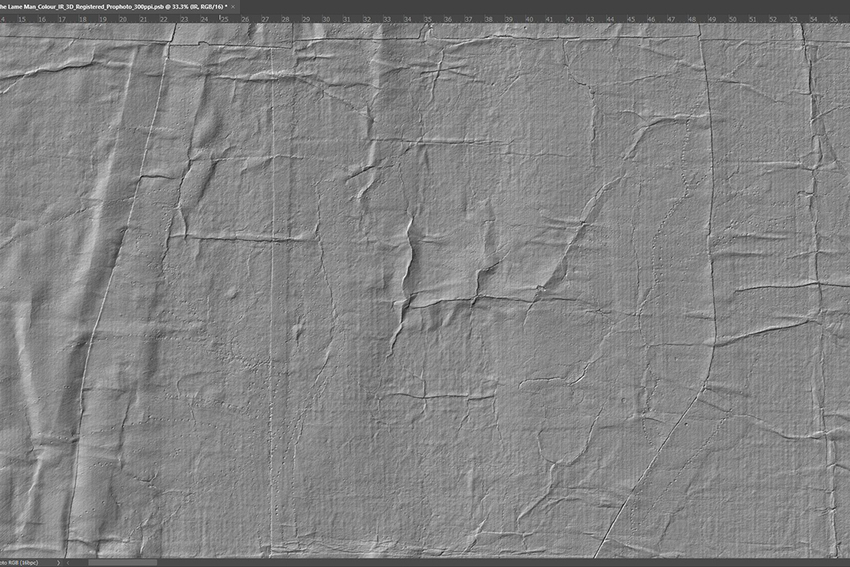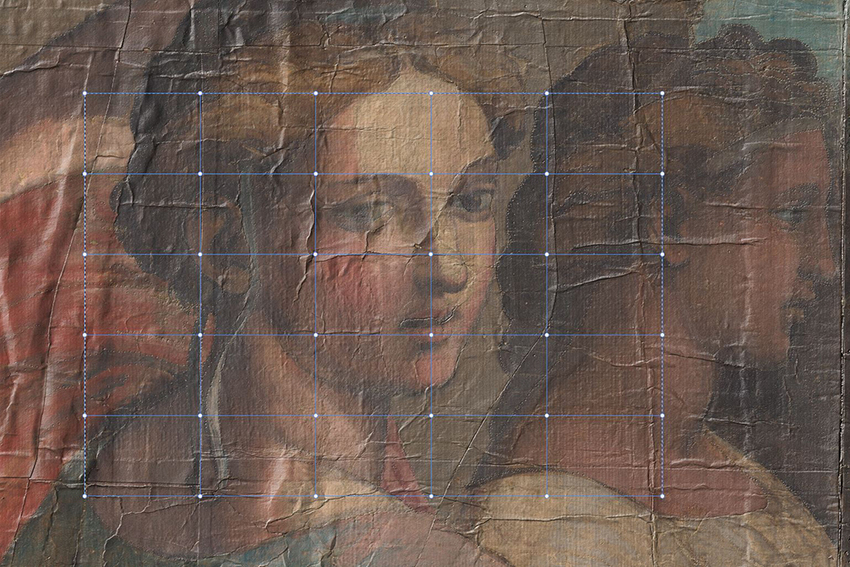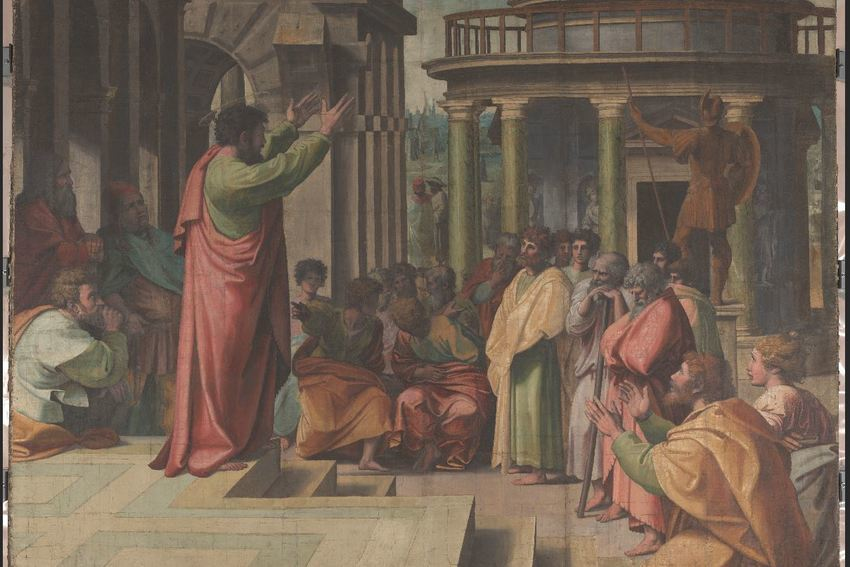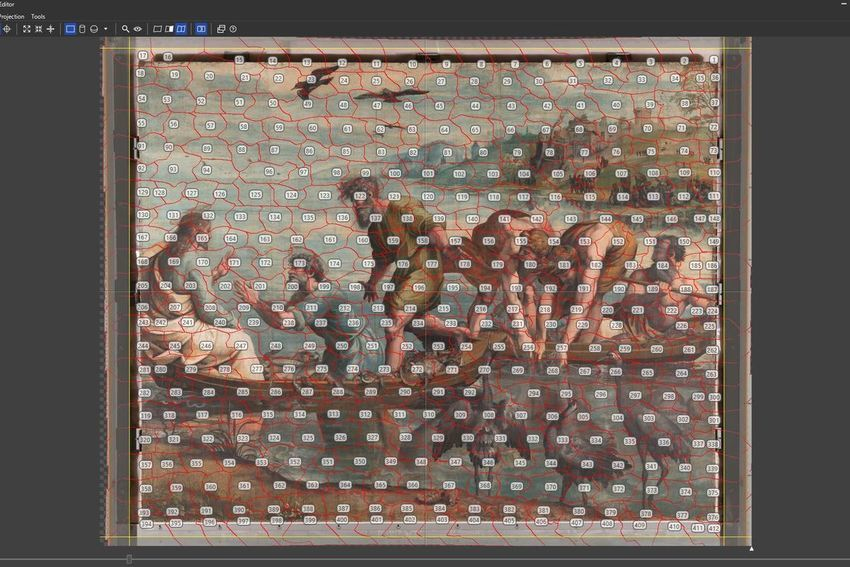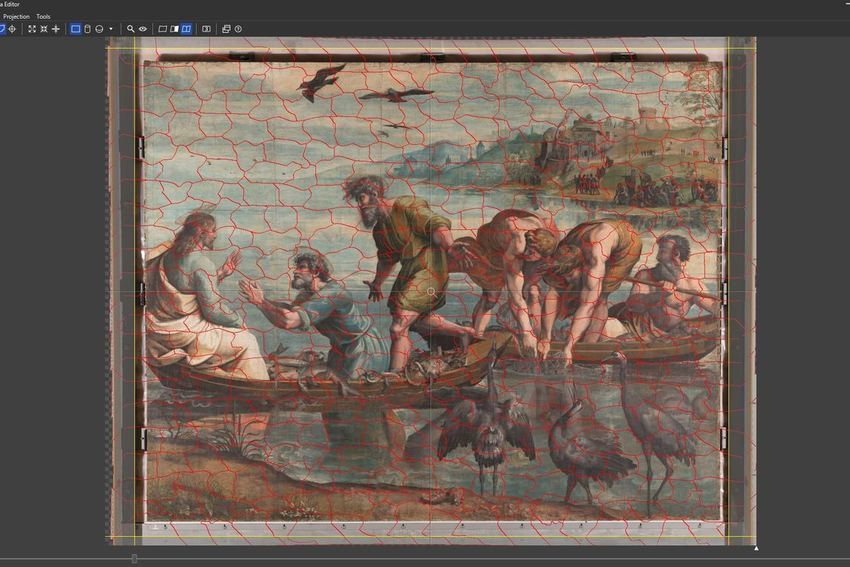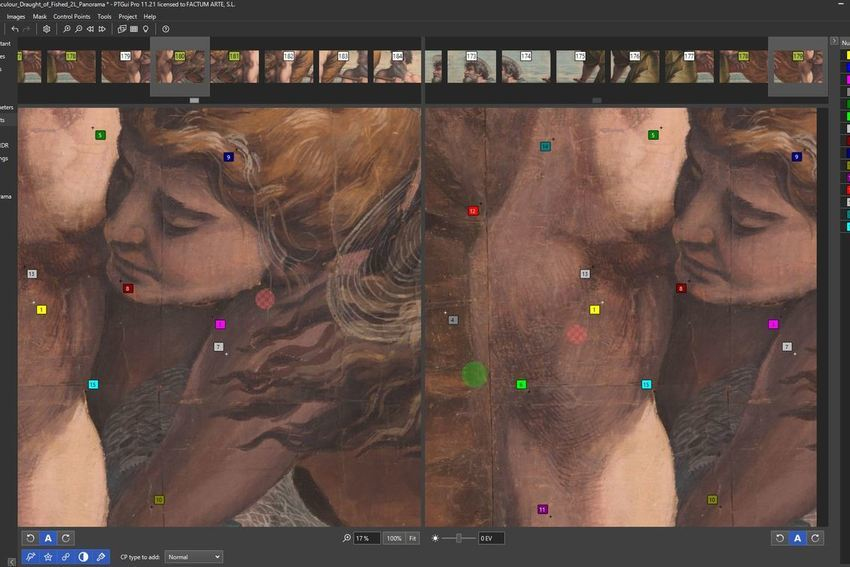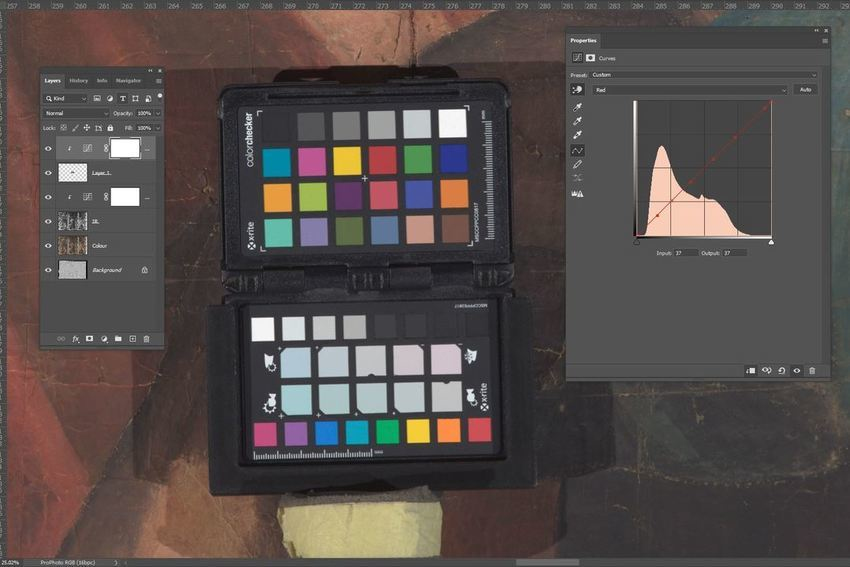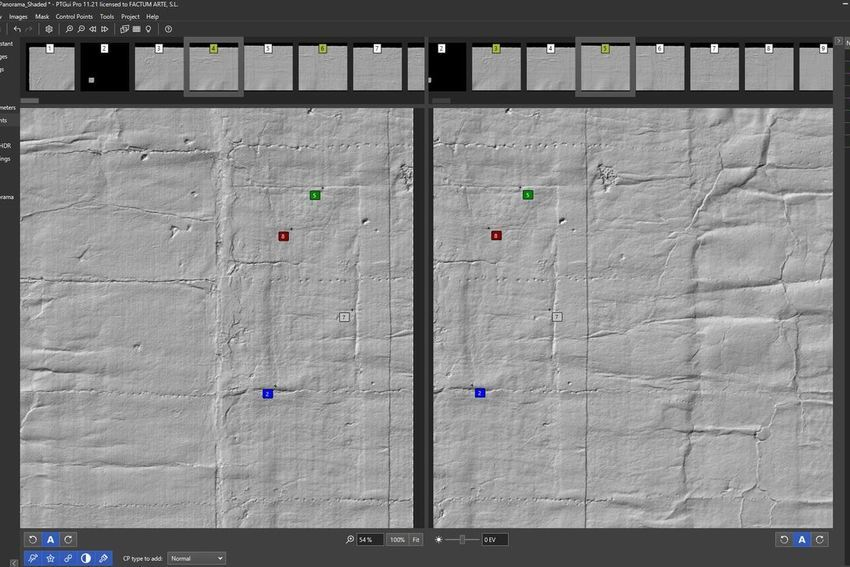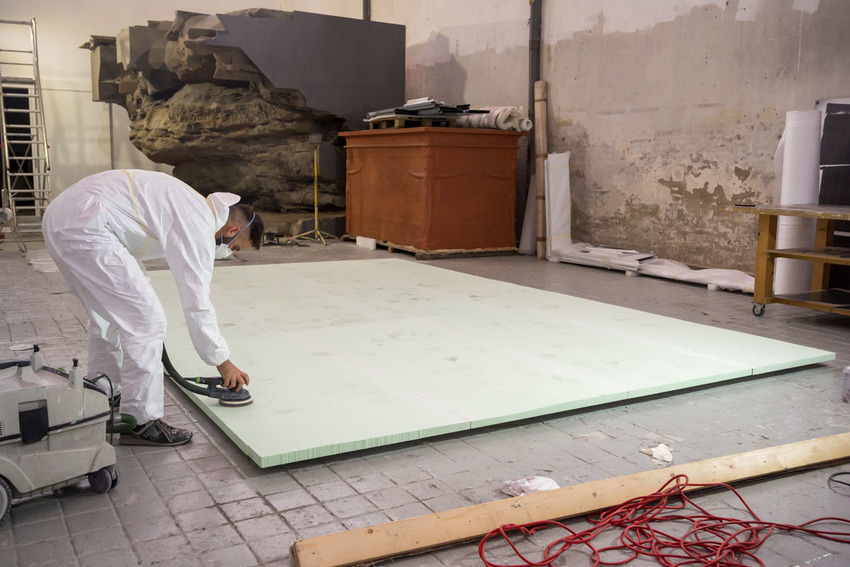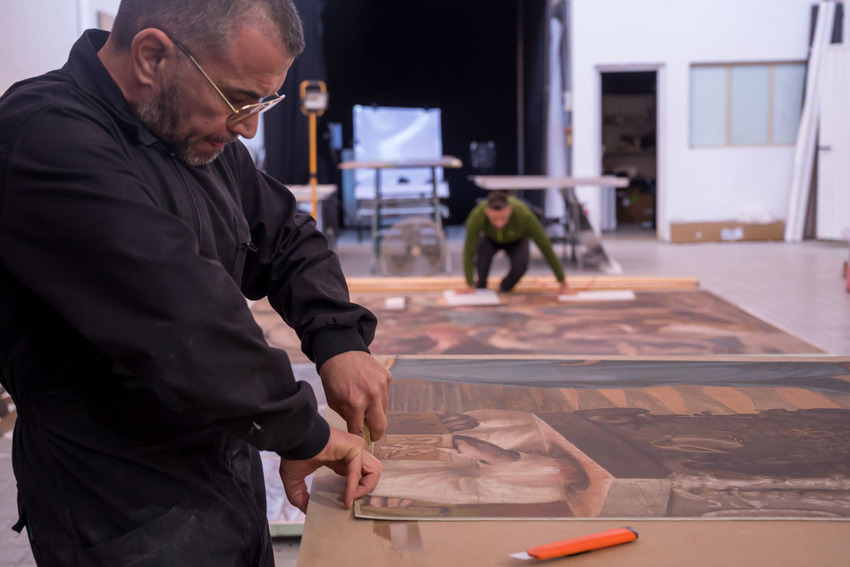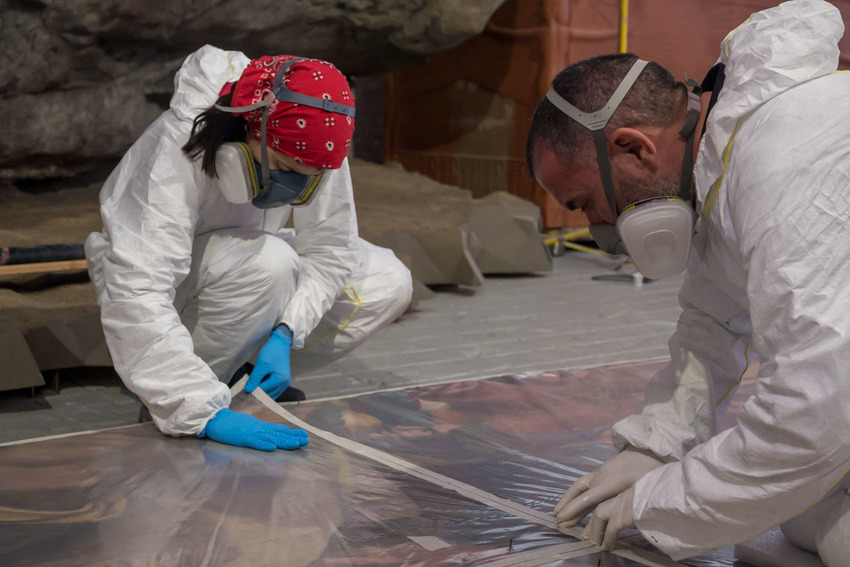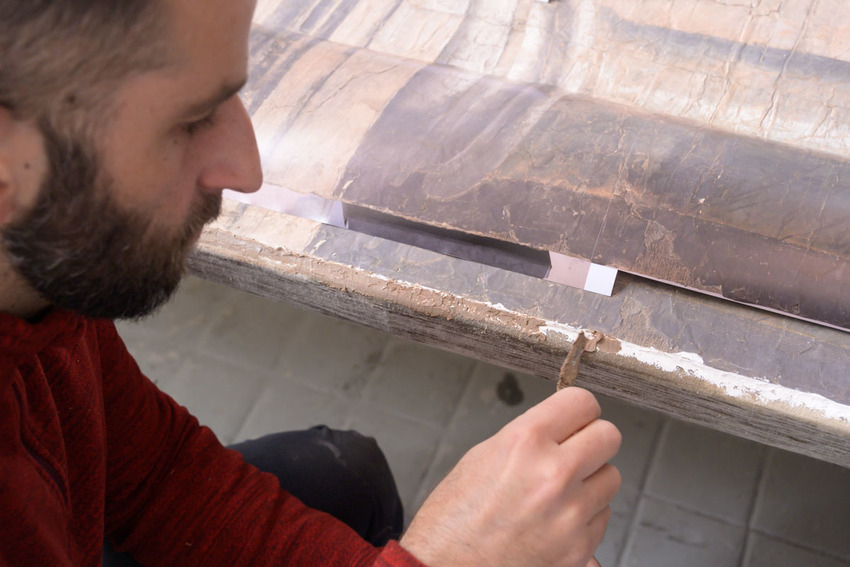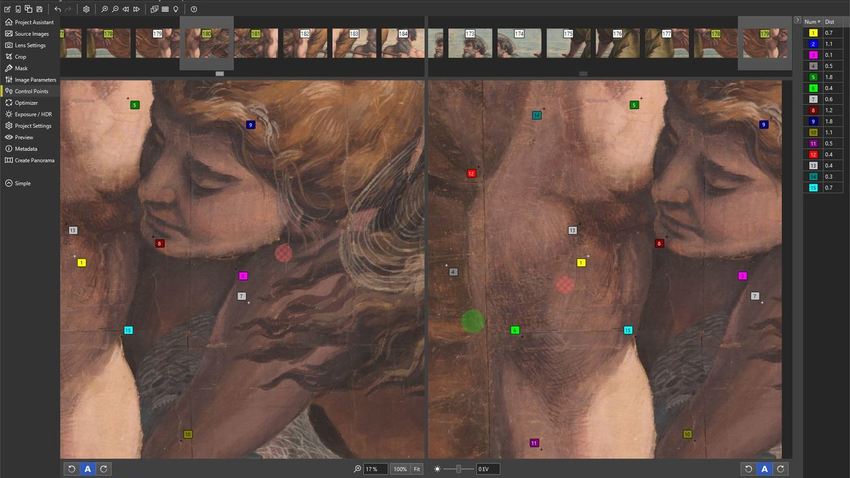
The Raphael Court during the recording © Gabriel Scarpa for Factum Foundation
The tapestry cycle was commissioned from Raphael and his workshop by Pope Leo X in 1515. The series was destined for the Sistine Chapel in the heart of the Vatican, and the ten designs depict the lives of the apostles Saint Peter and Saint Paul. While the ten final tapestries have survived, although they are rarely on display, only seven of the preparatory cartoons are still extant. These reappear in the record in 1623 within the collection of King Charles I, and since 1865 they have been displayed in the Raphael Court of the V&A Museum.
This project was one of Factum Foundation’s most ambitious digitisation projects to date and has set new standards for large-scale, high-resolution digital documentation of low-relief surfaces. It employed non-contact digital technology to capture detailed information for the surfaces of the seven monumental Cartoons and provided the original and processed data to the V&A for study and dissemination.
In order to complete the recordings, a team of specialists from Factum Foundation worked around the clock in three shifts for a period of five weeks, during which time the gallery was closed to the public. By following a carefully planned schedule it was possible to coordinate the recording of the Cartoons with the removal and replacement of the vast frames, the production of conservation condition reports, and other tasks carried out by the Museum’s staff. Fluent communication and coordination between the different teams were key to the success of the recording phase of the project.

The Momart team removed the frame of each Cartoon before the recording began © Factum Foundation

The frame of each Cartoon had to be carefully removed by the Momart team before the recording © Elizabeth Mitchell for Factum Foundation
A V&A conservator condition checks a Raphael Cartoon © Photo: Victoria & Albert Museum, London
Recording the surface
In the first phase of the project, a total area of about 115 square metres was digitised using two complementary non-contact methods: high-resolution panoramic photography, which was used to record both colour and infrared, and the Lucida 3D Scanner.
Conceived and developed by artist and engineer Manuel Franquelo with Factum Arte, the Lucida 3D Scanner is a close-range, non-contact laser recording system that captures high-resolution surface texture data for low-relief surfaces. It allowed the meticulous recording of surfaces which, while apparently flat, are in fact remarkably complex, made up of composite sheets of paper and showing the evidence of the painting process, pouncing, folding, and previous restoration treatments. This coherent high-resolution data can be used for accurate condition monitoring and for study.
The Lucida records 3D data in 48 cm x 48 cm ’tiles’ by projecting a moving laser beam onto the surface of an artwork. The beam is distorted as it moves across the surface and this data is captured by two video cameras positioned at 45° to the laser. The black and white video is automatically processed by the integrated scanner software to produce a render – an ‘image’ of the 3D surface, which is used to generate the 3D model. The system is entirely non-contact and the scanning head is always at least 8 cm from the surface of the artwork.
To produce accurate digital records of the Cartoons, four Lucida 3D Scanners were employed simultaneously to record the relief at a resolution of 100 microns (generating render images at 254 dpi at 1:1 scale). The scanners were mounted on scaffolding towers, reaching a maximum scanning height of about 5.5 m. The stability of the scaffolding, built by Momart, was essential to guarantee the highest level of safety for the cartoons and to produce optimal data quality.
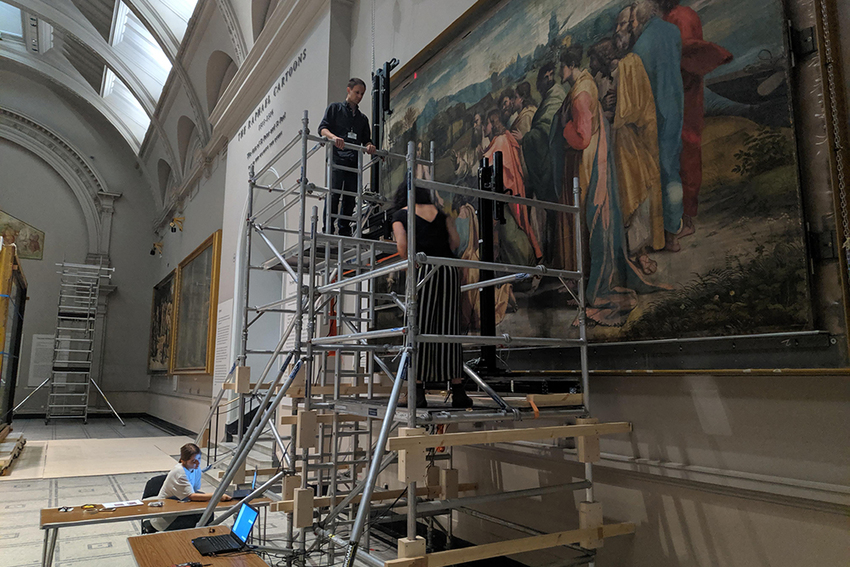
The Lucida 3D Scanner recording the surface of a Raphael Cartoon at the V&A © Gabriel Scarpa for Factum Foundation

The Lucida 3D Scanner is entirely non-contact and operates at safe distance from the artwork at all times © Factum Foundation
Recording the colour
At night, the Raphael Court was animated by the flash of hundreds of photographs, part of the process of panoramic photography. Factum’s photographers have spent many years perfecting this technique, which they use to create high-resolution colour recordings of flat or gently undulating surfaces.

Recording the colour of the Raphael Cartoons at the V&A using panoramic composite photography © Gabriel Scarpa for Factum Foundation
Many people are familiar with the basic concept of panoramic photography in which overlapping photos are stitched together to create a composite image. Factum uses panoramic photography to produce images of cultural heritage objects with resolutions of up to 900 dpi, following a set procedure to ensure the accuracy of the colour data. The process involves both digital colour checks using X-Rite colour-checking methods, and physical colour checks using Pantone charts and specially made ‘colour sticks’, which are matched to the colours on the painting. These checks are especially important in the production of facsimiles, ensuring accurate colour and tone and a close correspondence between the recording, the re-materialisation and the original painting.
During the photography process, flashes are used to evenly illuminate the surface of the artwork. The camera normally remains fixed, while the position of the flashes is changed at least 3 times.
The cartoons were recorded in colour and infrared at a resolution of 400–450 dpi at 1:1 scale.
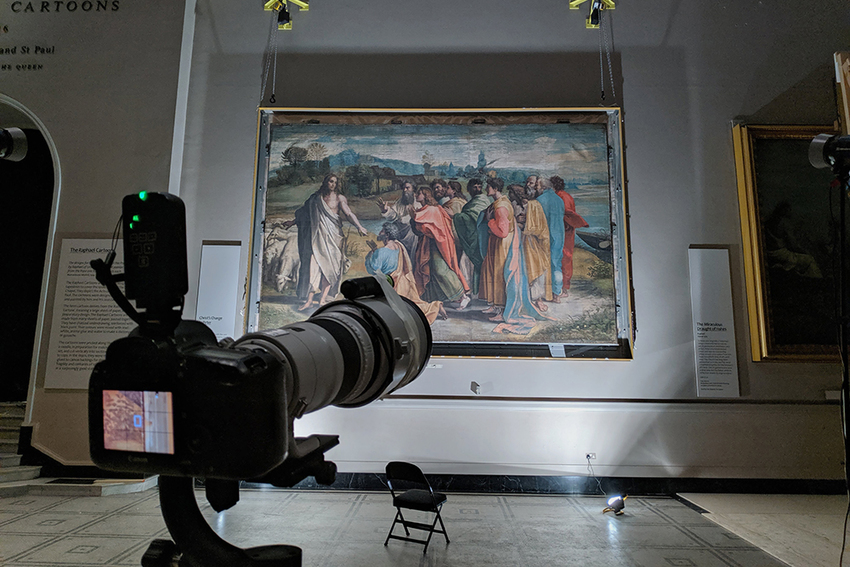
Recording the colour of the Raphael Cartoons at the V&A using panoramic composite photography © Gabriel Scarpa for Factum Foundation© Gabriel Scarpa for Factum Foundation
Creating the multi-layered browsers
The second phase involved processing the digital information captured on-site to render it suitable for different applications. During late 2019 and 2020, the raw files were carefully analysed, edited and stitched together to create the high-resolution composite images. Since the 3D data recorded by the Lucida system is generated as a greyscale depth-map and shaded image renders, it is possible to employ image-based software like PTGui to align the tiles; a similar semi-automatic process is followed with the photography and infra-red images. As a result of these stitching operations, three panoramas are generated for each Cartoon: a 3D render (which is used as a base), a colour file and an infra-red file.
Creating the infrared layer. RAW file from camera (left) and after the RAW development (right). © Factum Foundation for the V&A and Royal Collection Trust
On January 25th, the V&A launched a new online platform where the data from the Raphael Cartoons, recorded by Factum Foundation in high-resolution 3D, colour and infrared, was made available to the public for the first time. Through a new digital environment on the V&A’s website, users are able to engage with the Cartoons in new ways and at an unprecedented level of detail. The dataset from the recording, which was supported by the Royal Commission for the Exhibition of 1851, is accessible through a high-resolution multi-layer viewer.
While the reopening of the refurbished Raphael Court has been postponed due to a national lockdown in the UK, the COVID-19 pandemic has made the role of digital data increasingly relevant to museums as a means to sharing and disseminating their collections. Global access and making the data we record freely and publicly available is at the core of Factum Foundation’s mission, while ensuring that the data belongs to the museum responsible for the object, for all current and future applications.
V&A digital interactive, showing colour, 3D and infrared detail of the Raphael Cartoon The Death of Ananias. Photo: © Victoria and Albert Museum, London. Courtesy Royal Collection Trust / Her Majesty Queen Elizabeth II 2021
The seven surviving tapestry Cartoons by Raphael comprise a unique Renaissance treasure. At a time when the V&A’s doors are closed, we are delighted to share these incredible works of art with people at home to experience and enjoy, and we look forward to people visiting them in person once again – ready to be unveiled in their refreshed home – when the museum is able to reopen.
Dr Ana Debenedetti, Lead Curator of the Raphael Project and Curator of Paintings at the V&A
The facsimile of The Sacrifice at Lystra
Accurate recordings are essential for the production of an exact facsimile. A facsimile should be identical to the original under normal viewing conditions. They can be used for preservation and dissemination of the original and they are increasingly being used as a new way to share, reunite and experience culture. In 2020, the Cartoon depicting The Sacrifice at Lystra has been rematerialised as a facsimile for the exhibition ‘Raffaello (1520-1483)’ at the Scuderie del Quirinale in Rome, for which Factum Arte also rematerialised the tomb of Raphael (the original is in the Pantheon).
In Factum’s workshops, liquid silicon is then poured over the relief print to create a mould of its surface. A cast is then made from this mould using a specially prepared acrylic gesso mix. This ‘skin’, which forms the base surface of the final facsimile, is then fixed to a backing canvas in a process that is similar to re-lining a painting. In the case of The Sacrifice at Lystra, a CNC-milled polyurethane panel imitating the undulations of the original was used as support.
Factum’s purpose-built flatbed printer has been designed in-house to print in multiple layers across large surfaces. Using a traditional method of registration, the colour and the relief are perfectly aligned, ensuring that the appearance of the facsimile is entirely faithful to the original. Multiple layers of over-printing ensure that the tone and hue of each colour are exact. The final stage is varnishing and hand-finishing. In the exhibition in Rome, the facsimile was on display at eye level and without glass. The experience of seeing the tapestry and the Cartoon side by side opens many new avenues for study.

The facsimile within the exhibition spaces of ‘Raphael (1520-1483)’. Picture by Alberto Novelli © 2020 Scuderie del Quirinale – Ales

The facsimile within the exhibition spaces of ‘Raphael (1520-1483)’. Picture by Alberto Novelli © 2020 Scuderie del Quirinale – Ales
On 19th November, Michelle O’Malley from the Warburg Institute talked with Ana Debenedetti and Adam Lowe about the recording of Raphael’s Cartoons at the V&A in August 2019.
While the discussion focused on Raphael, it also looked more generally at the role of digital recording in light of the museum closures and the restrictions caused by COVID-19. High-resolution recording, display and rematerialisation technologies have serious implications for the study, display and dissemination of works of art – both online and offline access will be increasingly important in providing access to culture.


